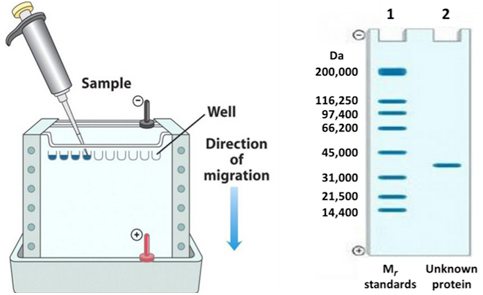
What is SDS-PAGE?
Polyacrylamide gel electrophoresis (PAGE) is a common technique used in biochemistry, molecular biology, genetics, and biotechnology to separate biological macromolecules including DNA, RNA, and proteins. Generally, it is the process of applying an electric field to move charged molecules through a solution in all forms of electrophoresis. In this technique, the mobility of a charged molecule is determined by its net charge, length and conformation.
The procedure for protein separation is called SDS-PAGE. Sodium Dodecyl Sulfate (SDS) is an anionic detergent, which means that its molecules have a net negative charge within a wide pH range when it is dissolved. It can be added to protein samples and turn the molecule into an unstructured linear chain. SDS also imparts negative charges to linearized proteins. A polypeptide chain binds lots of SDS in proportion to its relative molecular mass. Because the charge-to-mass ratio is nearly the same among SDS-denatured polypeptides, the final mobility of proteins depends only on the differences in their relative molecular mass. The negative charges on SDS are strongly attracted toward an anode in an electric field.
What is the principle of SDS-PAGE?
Polyacrylamide gel is composed of separating gel on the bottom and stacking gel on the top. The separating gel buffer usually contains 4-20% acrylamide and 1.5 M Tris-HCl, pH 8.8, while the stacking gel buffer contains 5% acrylamide (most used) and 1 M Tris-HCl, pH 6.8. Both of them consist of acrylamide, Tris-HCl, 10% SDS, 10% ammonium persulfate (AP) and TEMED. The concentration of acrylamide for separating gel depends on the range of proteins molecular mass.
During the electrophoresis, an electric field is applied across the gel, causing the negatively charged proteins migrate across the gel from the negative electrode towards the positive electrode (the anode). The most common electrophoretic buffer or running buffer is composed of Tris, glycine and methanol. For small proteins (< 15 KDa), Tris-tricine buffer is an appropriate choice. If you want to detect glycoprotein, Tris-borate buffer is better.
According to the pH of stacking gel, only a few glycine molecules are dissociated. Thus SDS-treated protein molecules are moving between glycine molecules above and Cl- ions below. Protein samples loaded into the gel can be compressed into a band of much smaller volume than were originally loaded. As the current continues to flow, the proteins move into the separating gel. Depending on their molecular size, each protein moves differently through the separating gel: small molecules more easily through the pores in the gel, while larger ones have more difficulty. After a period of time, the proteins have migrated different distances based on their size. Smaller ones reach farther down the gel, while larger ones remain in the upper gel. Migration occurs more quickly at higher voltages, but the results may be less accurate than those at certain lower voltages.
What is SDS-PAGE used for?
SDS-PAGE is usually used to estimate relative molecular mass, to determine the relative abundance of major proteins in a sample, and to determine the distribution of proteins among fractions. Different staining methods, such as Coomassie blue staining and silver staining, can be used to detect separated proteins and to get some information about their biochemical properties. Specialized techniques based on SDS-PAGE such as western blotting, native PAGE and two-dimensional electrophoresis can be further used to detect and separate complex protein samples.
Sample preparation
- The sample preparation should be kept in the shortest time to avoid protein losses;
- Lysis of cells or tissues should be kept cold to avoid protein modifications and prevent enzyme activities;
- Different protein inhibitors should be added into lysate according to the characteristic of target proteins.






